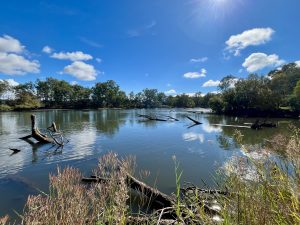Last month Parklands Ranger Chris Allen was intrigued to find a new plant beside the Murray river on Grays Island. On investigation, Chris was horrified to identify the plant as the invasive Moth Vine (Araujia sericifera).
Moth Vine, a plant originating in South America, is a very nasty weed indeed, and one not found previously in our region.
Also known as ‘cruel vine’ and ‘stranglehold plant’, Moth Vine’s alternate names give clear warning of it’s nature. Poisonous to both humans and animals, moth vine is a long lived, rapidly growing vine that quickly smothers all other vegetation. It’s twining stems produce multiple fruit pods, each with up to 400 seeds. The seeds are easily spread by wind and water and stick to clothing and animal fur.
Chris’ sighting, submitted to the Albury Wodonga Nature Map, is the first digital record of this weed in our region, and rings alarm bells for community, farmers and environmentalists alike.
With invasive plants like this being one of the most significant factors in the calamitous decline of our native ecosystems, the appearance of Moth Vine locally is potentially disastrous. Finding what we hope was one single plant also provides a window of opportunity to stop the spread.
Parklands are calling on all users of the river and the regional parklands to put this nasty weed on your radar, and follow up immediately if you find it.
Useful actions are:
- Remove or treat it, especially if it is flowering or fruiting. Preventing any reproduction is top priority. The NSW Weedwise site has useful information on appropriate controls.
- Digitally record the sighting – take a geo-located photo and upload to a citizen science site that is linked to the Atlas of Living Australia. iNaturalist and Nature Mapr both do this.
- Report the sighting to the land owner or manager.
The plants Chris found have been carefully removed and no fruits were found. Parklands Rangers will be checking and rechecking in the vicinity for any further seedlings, and with community vigilance, hope that this weed can be stopped before it gets hold in the regional parks.
For identification and control notes, find out more on NSW Weedwise. Community members can also join Parklands River Stewards to help spot weeds like this on public land and get involved in restoring the river parks.






